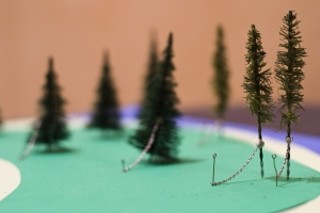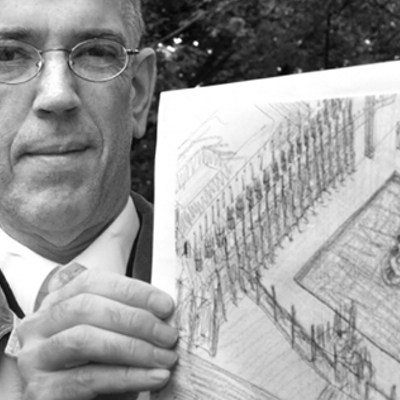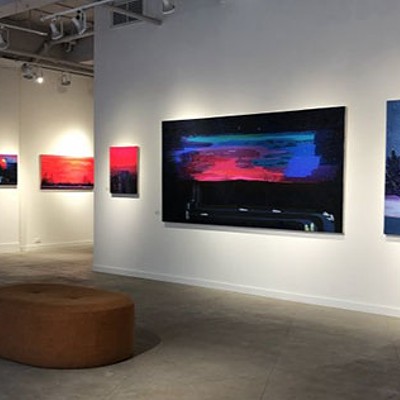If Noah Logan has his way, Point Pleasant Park will be ready for its next hurricane. The third year NSCAD student has hatched an elaborate plan to keep the trees rooted to the ground the next time gale force winds feel compelled to take ’em down---and it involves chains. “If they blow over,” he explains, well aware of the humour in his notion, “we can just pull them back up and pop them back in (the ground).” To illustrate his idea, he’s built a model of his chained forest at one end of NSCAD’s new PORTloggia gallery. There, a handful of sturdy tree trunks (the real-life version would include 1,000 trees) stand at attention in rough piles of dirt, their chains pulled taut and locked off with padlocks. Inspired by a chained-up lifeguarding station he saw while visiting the park, Logan admits his tongue-in-cheek work pokes fun at our human instinct to reign in our natural environments, even when beyond our control.
The piece is one of five sculptural models on view as part of the Regenerate Point Pleasant Park project, an end-of-term exhibition by the students in Sculptural Propositions, a senior-level NSCAD class taught by Kim Morgan. The students were assigned the task of responding to a fantasy public sculpture competition, wherein they were asked to design site-specific works for the park that addressed the environment in some way. Playing out exactly the way a real municipal call-for-work might, the students were required to submit proposals, draw up budgets for using the imaginary $150,000 prize, and submit conceptual drawings before creating scale models of their works. Knowing the work never had to be realized allowed the students to let their conceptual imaginations run free. In Alex Gaskin’s “Unnatural Forest,” full-sized trees grow both upwards and downwards from an elevated, dirt-filled raised platform he imagines building in a swath of park greenery. Inspired by a “contraption to grow tomatoes upside down,” Gaskin’s proposed 150-foot platform would provide a lookout spot for people to contemplate the natural forest while engaging directly with an unnatural one. His doll-scaled model reveals hollow interior pillars designed for letting the sun penetrate through. Nearby, Charlene Heilman has constructed a Plexiglas box half-full of water and outfitted it with clothesline pulleys linked by a large rubber band and a crank. An ordinary teaspoon is affixed to the rubber band, and when the wheels are turned, it dips in and out of the liquid, decanting a tiny amount of water like an ineffectual waterwheel. The contraption, which would sit on the seabed where it would respond to the tides, is called “Spooning the World’s Problems Away, One Spoon at a Time.” Heilman has a background working in social services and she says her piece references her experiences working with drug users and mental health patients. “It’s frustrating ’cause you can’t get anything accomplished as a worker,” she says. “I always felt like I was spooning away the problems one spoon at a time.” Also working with the tides is fourth-year sculptor Sarah Robinson, who proposed the building of a series of saltwater swimming pools along the park’s north-west shore. The family-friendly pools would be filled by underground, tide-fed channels, armed with environmentally sensitive filters to whisk away harbour nasties and other bacteria. Mimicking nature, her model pool has a working pump to siphon water through. Robinson is interested in the idea of communal spaces and enjoyed the process of creating something that engages on a more community level. “It’s different from how I normally work,” she says, “but I really enjoyed seeing how something would fit in the actual world, rather than just in my studio.” David MacFadden’s elegant proposal for a large-scale earthwork is laid out on the floor nearby. It’s a thick, snake-like mound of grass and hay combed in a single direction---a hint of what he would create in an outdoor environment, the scale and material to be determined by found materials. For her part, professor Morgan says she’s thrilled by the results and by the exhibition, which inaugurates the PORTloggia space. “At the end of a public art competition, the models (for consideration) would be set up for the public to come and give feedback,” says Morgan. “The students really rose to the occasion.”Pleasant Regeneration runs until Sunday, December 14 at PORTloggia, 1107 Marginal, 442-8769.Park life
Five NSCAD sculpture students respond to a fantasy public art competition for Point Pleasant Park.
[
{
"name": "Air - Inline Content - Upper",
"component": "26908817",
"insertPoint": "1/4",
"requiredCountToDisplay": "8"
},{
"name": "Air - Inline Content - Middle",
"component": "26908818",
"insertPoint": "1/2",
"requiredCountToDisplay": "8"
},{
"name": "Air - Inline Content - Lower",
"component": "26908819",
"insertPoint": "100",
"requiredCountToDisplay": "1"
}
]














